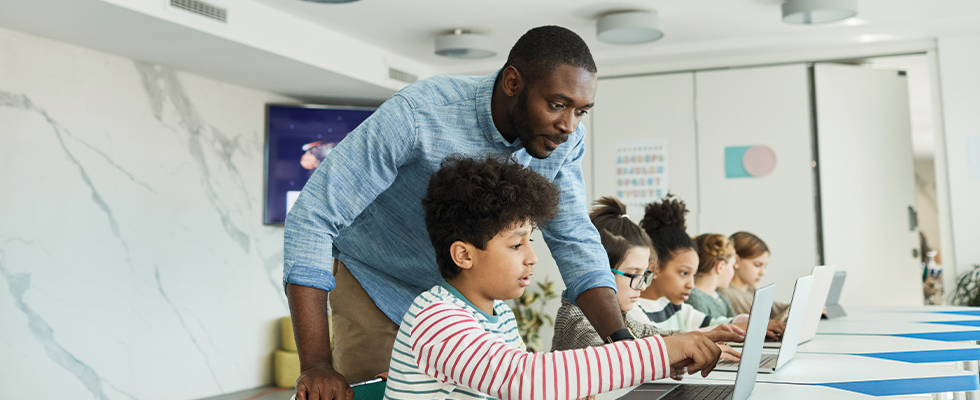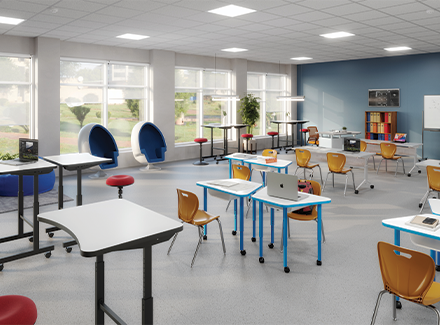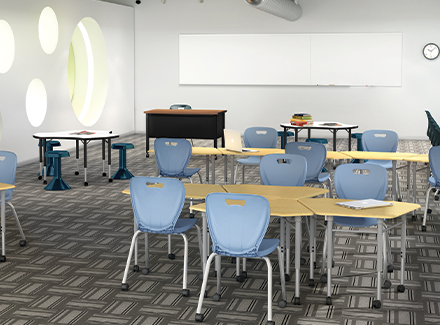
As the school furniture partner for hundreds of districts around the country, we see just how challenging learning loss is for them. The pandemic may be in the rearview mirror for most, but for teachers and administrators of early learning, K-12, and special education students, the impacts are still front-and-center. So, what are schools doing today to combat learning loss? It turns out they're making headway, and students are rebounding.
While summer educational programs, tutoring initiatives, and exhausted ESSER and EANS funds have helped some, many districts are finding student achievement and improvement with flexible learning spaces. Here, we'll take a look at how schools plan to accelerate learning recovery and they're finding revolutionary new ways to do it with classroom furniture.
Learning loss by the numbers in 2024
You're not alone in facing challenges associated with learning loss. To close the gap, many districts have turned to summer learning and robust tutoring programs, many funded by remaining ESSER and EANS funds. Results of those investments show marginal improvements in student outcomes. And as some test scores improve, educators still contend with student mental health needs and chronic absenteeism. Here's a snapshot of today's learning loss, by the numbers:
The Hill recently reported that studies have shown extreme learning loss in reading and mathematics, especially among already low-performing students. The latest disappointing numbers came from a Program for International Student Assessment exam that found U.S. students hit an all-time low in mathematics.
While reading has had some recovery, U.S. students are still well behind in important topics despite major financial investments in education and targeted programs such as high-dose tutoring.
Billions of dollars have been spent just trying to fix the COVID-19 fueled learning loss problem, but those investments have not yielded the hoped for results.
Schools have been aggressively seeking solutions and data, as some of their biggest barriers to moving forward have included chronic absenteeism, defined as missing more than 10 percent of school days.
The New York Times reported that students have now recovered roughly one-third of what they lost during the pandemic shuttering and remote learning requirements. EdWeek shared similar findings, showing that between spring 2022 and 2023, students gained one-third of their original math losses and one-quarter of their original reading losses.
Students in just four states-Alabama, Illinois, Mississippi, and Louisiana-met or exceeded their pre-pandemic achievement levels in 2023. All other U.S. states still showed a net loss in achievement, says EdWeek.
2024 trends related to school furnishings and learning recovery
School Outfitters works with thousands of school districts across the country, and we see common challenges educators face. We can also share trends relating to how schools are finding new ways to furnish their classrooms and spaces to accelerate learning recovery. Yes, learning loss, chronic absenteeism, behavioral challenges, and federal funding expiration are happening. But so are the success stories. Three of the most significant trends include:
Learning recovery is happening and can be accelerated in new ways
Learning recovery is being achieved through innovative methods such as personalized instruction, digital tools, and flexible learning environments that address diverse student needs and learning gaps.
Flexible learning spaces can support student achievement
Flexible learning spaces enhance student achievement by providing adaptable environments that cater to various learning styles and activities, thereby fostering engagement and collaboration.
Educators prefer flexible, deconstructed learning spaces
Educators favor flexible, deconstructed learning spaces as they allow for dynamic teaching strategies and more effective student-centered learning experiences.
What is a flexible learning space?
Any classroom, learning space, or common area can become "flexible." Typically, what differentiates a traditional space from a flexible space are furnishings that allow for mobility, flexibility in seating arrangements, adaptive pedagogies, and varying approaches to teaching and learning.
What's more exciting are the positive impacts flexible learning environments can have:
Teachers: 63% of teachers with flexible learning spaces say they're better and more effective teachers.
Students: 73% of administrators with flexible learning spaces in their schools believe they support student learning and achievement.
Seen & Heard: 2024 Voice of Educators Survey
How flexible learning spaces support key drivers of learning recovery
Flexible learning spaces support key drivers of learning recovery by creating adaptable environments that cater to diverse student needs and learning styles. It's about meeting individual students where they are in loss and recovery. These spaces can be reconfigured to support various teaching methods, from collaborative group work to individual study, fostering a more engaging and inclusive atmosphere. By allowing for movement and varied seating arrangements, flexible learning spaces can enhance student focus and motivation, critical components for effective learning recovery.
Additionally, the integration of technology in these adaptable spaces ensures that students have access to digital resources, facilitating personalized learning and the reinforcement of key concepts. This dynamic approach to classroom design helps to address learning gaps and accelerates educational progress post-disruption.
Administrators surveyed in Seen & Heard: 2024 Voice of Educators Survey shared their beliefs about how flexible learning spaces support learning recovery.
84% of respondents believe flexible learning spaces support communication.
80% of respondents believe flexible learning spaces support student engagement.
75% of respondents believe flexible learning spaces support better listening.
74% of respondents believe flexible learning spaces support concentration.
How flexible learning environments support accelerated learning and improve essential skills
Flexible learning environments support accelerated learning and improve essential skills by fostering adaptability and student engagement. These spaces are designable to accommodate various teaching styles and learning activities, allowing for a seamless transition between individual, group, and whole-class instruction. This flexibility encourages collaboration, critical thinking, and problem-solving, which are key components of accelerated learning. By providing access to diverse resources and incorporating technology, flexible learning environments also enhance digital literacy and communication skills. These adaptable settings empower students to take ownership of their learning, improving academic performance and the development of essential life skills.
Administrators surveyed in Seen & Heard: 2024 Voice of Educators Survey shared their beliefs about how flexible learning spaces can improve and support students' essential learning skills.
46% of respondents believe that flexible learning spaces improve student attendance.
68% of respondents believe that flexible learning spaces support student behavior.
65% of respondents believe that flexible learning spaces support student mental health.
84% of respondents believe that flexible learning spaces support students' special needs.
Today's schools are investing in these learning spaces
Over the next five years, schools are preparing to invest in these learning spaces, outfitting them with flexible furnishings and elevating student engagement, seeking to improve outcomes
Survey respondents in Seen & Heard: 2024 Voice of Educators Survey shared these spaces as top priorities for their schools in the coming years:
40% plan to invest in calming spaces
33% plan to invest in STEM rooms
33% plan to invest in core classrooms
31% plan to invest in inclusive learning
28% plan to invest in career and technical education
26% plan to invest in outdoor learning spaces
25% plan to invest in special education
24% plan to invest in makerspaces
How today's teachers prefer to use their flexible learning spaces the most
Flexible and collaborative school furniture can support a host of learning recovery efforts. And if you're like many of the teachers who participated in our Seen & Heard: 2024 Voice of Educators Survey, you'll want:
Spaces that can be quickly transformed into group work or other activities
Spaces to collaborate with students
Technology integration for audio and visual learning
Adjustable height desks and tables
Chairs to support physical movement and fidgeting
Whiteboard surfaces on desks and tables
Demonstration spaces
Inclusivity for students with mental and physical differences
Top 5 advantages you can expect when you adopt more flexible furniture
Flexible furniture allows for easy reconfiguration of classroom layouts, fostering collaboration, creativity, and active learning among students. Additionally, flexible furniture can contribute to a more engaging and dynamic learning atmosphere, which can improve student focus and participation. It can also help maximize the use of available space, making the classroom more efficient and conducive to learning.
The most significant benefits of flexible furnishings in the classroom include the ability to:
Provide supportive classrooms
Create tutoring areas
Extend learning time and places
Enhance emotional and social support
Improve equity and inclusion


Support learning recovery with flexible learning spaces and School Outfitters
As your school seeks new ways to close the gaps in learning loss for your students, consider flexible learning spaces. And to outfit those spaces with modern, innovative furniture that allows for functionality, mobility, and inclusivity, trust School Outfitters. Contact your furniture expert representative today to see how a few desks, chairs, tables, and storage solutions can dramatically improve the learning experience for your students. Browse our quick ship products for back-to-school deadlines and get a free quote!



